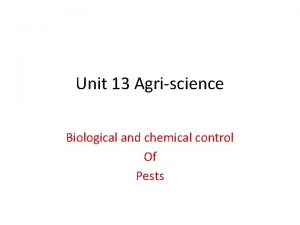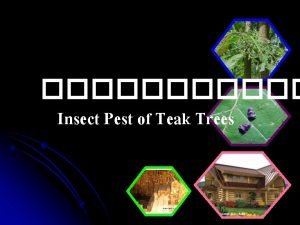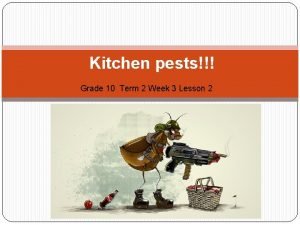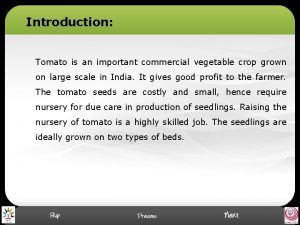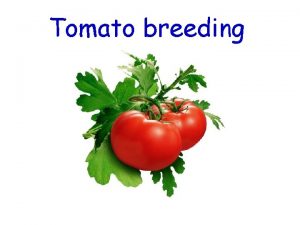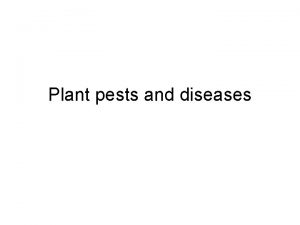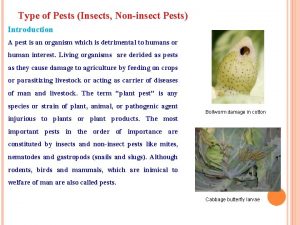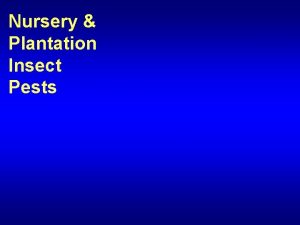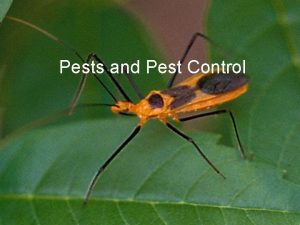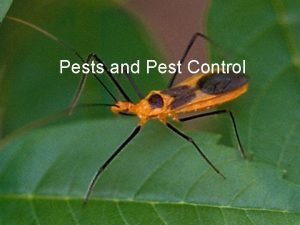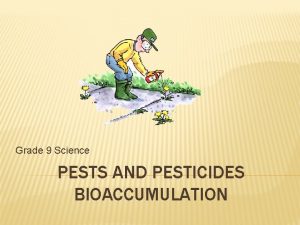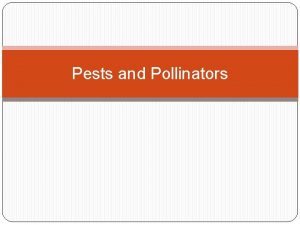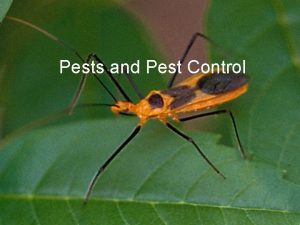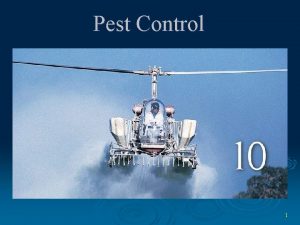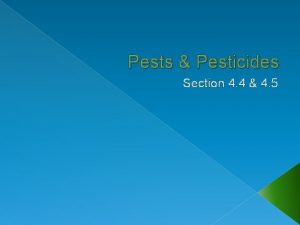Tomato Major Pests Introduction Tomato is one of














- Slides: 14

Tomato: Major Pests

Introduction Tomato is one of the world’s most important horticultural crops. It should therefore be no surprise that there a large number of pests that attack this crop. This unit will introduce the main pests that a tomato farmer is likely to encounter. There are some key categories of pests to consider: • Those that transmit viruses (aphids, whitefly and thrips) • Those that directly attack the fruit (caterpillars and some sucking bugs) • Those that damage the plant in some way so that it is less productive (many different pests) In many countries, this is the order in importance of the pests that attack tomato. Photo credit: Scot Nelson

Disease Vectors Viruses can cause very serious plant diseases because they are incurable once they are established inside a plant. Their impact is greater if infection occurs in young plants. Literature reports that there around 136 different viruses that attack tomato around the world. Only cucurbits have more. Most serious tomato viruses are transmitted by insects – especially by aphids and whitefly. It is difficult to stop these insect vectors because they can transmit the virus at low population levels, which are difficult to detect. They are also able to transmit the virus rapidly through the crop and symptoms do not develop immediately, which means that detection often occurs too late. Some important insect vectored viruses include: • Cucumber Mosaic Virus (CMV) – Aphid vectors • Tomato Yellow Leaf Curl Virus (TYLCV) – Whitefly vectors • Tomato Spotted Wilt Virus (TSWV) – Thrips vectors Tomato Yellow Leaf Curl Virus (TYLCV)

Aphids • Aphids are small, soft-bodied insects. • They are common insects that can be often found on the underside of leaves. • Winged adults enter the crop from weeds and from other crops. • Adult females give birth to live young (all female) and these rapidly develop into adults. • Within two weeks, these new adults are producing the next generation. • They usually transmit viruses non-persistently, which means that they can pick up and transmit viruses rapidly. It also means that they can lose them easily if a live barrier slows their entry into a field. • Weed control is critical because aphids pick up viruses from weeds and also build up populations before entry into the crop. • There a number of natural enemies such as ladybird beetles and syrphid larvae. Winged or ‘alate’ aphid adult Aphid colony on the underside of a leaf

Whitefly • Whitefly adults are easily disturbed when plants are moved. • The nymphs are not so easy to find – pale yellow disks on the underside of leaves that look nothing like the adults. • The lifecycle can be completed in under a month and populations increase rapidly. • Common species such as Bemisia tabaci & Trialeurodes vaporariorum have a wide host range and are always found on weeds. • They vector important viruses of tomato and they do so in a persistent manner, which means that they carry the virus their entire lives. Live barriers have limited impact. • Because of being persistent vectors, they have to spend more time feeding to acquire the virus. It also takes them more time to transmit it to uninfected plants. For this reason, systemic insecticides are useful in slowing introduction and transmission of the virus. • There are important natural enemies such as predatory mites and parasitic wasps. Adult whitefly Whitefly nymphs

Thrips • Thrips are small, narrow-bodied insects that are common but often overlooked on plants. Adults are 1 -2 mm in length. • The adults have wings which they fold along their backs. The immatures do not have wings. • Thrips are most attracted to flowers, but can also be found on the underside of leaves and on developing fruit, close to where the fruit attaches to the plant. • They cause damage by direct feeding, causing silvering and malformation of leaves and marking of fruit. • Their greatest damage is caused through the vectoring of the Tomato Spotted Wilt Virus (TSWV), a global disease. • Affected plants are stunted and fruit can exhibit circular damage and discoloration. • Weed control, reflective plastic mulches and use of agrochemicals that induce Systemically Acquired Resistance (SAR) lowers thrips numbers in the field. • Thrips are resistant to many insecticides especially pyrethroids, carbamates and organophosphates. Insecticides in the spinosyns class are the most effective but resistance needs to be managed. Thrips nymph (credit M. J. : CC BY-SA 2. 0 DE) Adult Onion Thrips left (T. tabaci) and Western Flower Thrips right (F. occidentalis) (credit Alton N. Sparks, Jr: CC BY 3. 0)

Direct Damage To Fruit Insects that cause damage directly to the fruit can be divided into those that have chewing mouthparts and those that have piercing/sucking mouthparts. The former make obvious holes and damage to the fruit while the latter causes more subtle damage, which can often only be seen when the fruit is mature. Insects with chewing mouthparts Lepidoptera larvae • Tomato Fruitworm (Helicoverpa zea), • African Cotton Bollworm (Helicoverpa armigera), • African Cotton Leafworm (Spodoptera littoralis) • Tomato leafminer (Tuta absoluta) Insects with piercing/sucking mouthparts Hemiptera or true bugs • Stink bugs (e. g. Nezara viridula) • Leaf-footed bugs (e. g. Leptoglossus clypealis) Damage circled

Chewing Mouthparts Tomato Fruitworm (Helicoverpa zea) • An important pest in the Americas • Attacks many different plants • The larvae can be different colors (e. g. brown, green or pink) • Scouting is important because insecticides are most effective against larvae recently emerged from the egg. • Insecticide resistance is a problem. Helicoverpa. zea (Credit: Flex; CC-BY-SA- African Cotton Bollworm (Helicoverpa armigera) • Widespread distribution apart from the Americas (although recently established in Brazil) • Attacks many different plants • The larvae can be different colors (e. g. green & brown) • Scouting is important because insecticides are most effective against larvae recently emerged from the egg. • Insecticide resistance is a problem. 3. 0) Helicoverpa. armigera (Credit: Gyorgy Csoka; CC-BY-3. 0 US)

Chewing Mouthparts African Cotton Leafworm (Spodoptera littoralis) • This pest is found in Africa, Middle East and Europe • It attacks a wide range of crops (over 87 commercially important species). • The larvae feed on both the leaves and the fruit. • Scouting is important because insecticides are most effective against larvae recently emerged from the egg. • Insecticide resistance is a problem. Spodoptera littoralis (credit: David Marquina Reyes; CC BY-NC-ND 2. 0) Tomato leafminer (Tuta absoluta) • This pest is found in S. & C. America, Africa, Middle East and Europe • The larvae turn from a cream color to a green color and finally turn a little pink before pupating. They are small - under 1 cm in length. • In addition to attacking the fruit, they mine leaves and can remove all leaf material. • They produce webbing, which helps the larvae move about the plant. • Insecticide control is difficult because the pest hides inside the plant. Some systemic insecticides are effective but resistance is a problem. Tuta absoluta larva emerging from fruit (circled)

Piercing/Sucking Mouthparts Stink bugs (e. g. Nezara viridula) • These hemipteran insects feed on the fruit, preferring the green, immature fruit. • They cause spots and blotches that are difficult to see until the fruit ripens and differences in color appear. • The tissue under the damaged skin of the fruit can also become hard or ‘corky’. • Weed control is important for keeping numbers of these pests down. • These pests are normally found on the ground or low on the plant, so insecticide sprays need to use high volume and good coverage to reach the insects. Leaf-footed bugs (e. g. Leptoglossus clypealis) • These are similar to stink bugs and they cause similar damage • Again, weed control is important These pests are not as damaging as others that attack fruit and some markets will accept the minor damage they cause. Credit: David Riley (CC-BY-3. 0)

General Tomato Pests These pests damage the tomato plant in various ways so that it is unable to function properly, leading to yield reductions. Damage to Roots Root Knot Nematode • These are microscopic (0. 2 mm in length), worm-like, soil organisms. • This pest attacks many different crops and damages them by causing swollen root nodules that prevents normal root function. • Wilting of the plant, during the heat of the day is a sign that the crop is infested. • The root damage also allows diseases to enter the plant. • Sandy soils suffer more root knot nematode problems and increasing organic material is a recommended control practice. • Chemical control is almost impossible. Rotation with nonhost crops is recommend. Damaged root

General Tomato Pests Damage to Canopy Spider Mites • These small pests can be a serious problem under hot, dry conditions. • They are pale in color with dark patches but can also turn red. • The lifecycle can be completed in under a week and populations grow rapidly. • At high populations the mites produce a webbing on the plant. • Their feeding activity causes a whitening of the leaves and loss of chlorophyll for photosynthesis. • There are some effective miticides but they have to be applied every 3 -4 days because the egg stage is largely immune to miticides. • There are effective biological control options but they only work when spider mite populations are low. • Scouting at least twice a week is important to catch an outbreak early. • Weed control is also critical to prevent entry into the field. An adult walking among eggs

General Tomato Pests Damage to Canopy Leafminers (e. g. Liriomyza trifolii) • The adults are small, brightly colored flies. Their larvae tunnel inside the leaves of many different crop and weed plants, causing characteristic leaf damage. • Diseases such as Early Blight uses this damage to enter the plants and cause further damage. • This pest has a number of natural enemies, which normally keep it from causing economic damage to the crop. • Normally the larva is a pale yellow color and found at the fattest end of the mine. When the larva is a dark color, it means it that it has been killed by a parasitoid or disease. If it is missing from the mine, it could mean that an ant has removed and eaten it. • Indiscriminate use of pesticides kills these natural enemies and secondary pest explosions of leafminer can occur. The pest larvae are largely protected inside the leaves. • Insecticides with translaminar or systemic activity are effective at controlling this insect. A yellow larva at the end of its mine

Integrated Pest Management All of the pests covered in this presentation have the ability to cause serious damage. Whether this happens or not depends on the management and planning of the farmer. Fintrac recommends the use of Integrated Pest Management. This is an approach to crop protection that uses different strategies to prevent pest problems: • Prevent the build up of pests on the farm o Crop rotation o Weed control • Early detection and identification of incoming pests o Farmer knowledge of the anticipated pests o Scouting o Yellow sticky traps • Cultivation of a healthy, robust crop that can remain productive despite a pest attack • Strategic control activities o Careful selection and use of pesticides o Use of pest population thresholds to increase efficient use of pesticides o Use of alternative control methods such as live barriers, reflective mulch and biopesticides. This concludes the unit on Tomato Pests. The next unit will focus on Diseases.
 Agriscience unit 13 completion answers
Agriscience unit 13 completion answers Poinsettia pests
Poinsettia pests How does a plant resist disease and pests journey 2050
How does a plant resist disease and pests journey 2050 How does a plant resist disease and pests journey 2050
How does a plant resist disease and pests journey 2050 Teak insect
Teak insect Pests can cause which two types of contamination
Pests can cause which two types of contamination Flour bugs that fly
Flour bugs that fly Introduction of tomato
Introduction of tomato Solanum cheesmanii
Solanum cheesmanii One empire one god one emperor
One empire one god one emperor One one one little puppy run
One one one little puppy run One king one law one faith
One king one law one faith One empire one god one emperor
One empire one god one emperor One ford plan
One ford plan See one do one teach one
See one do one teach one
